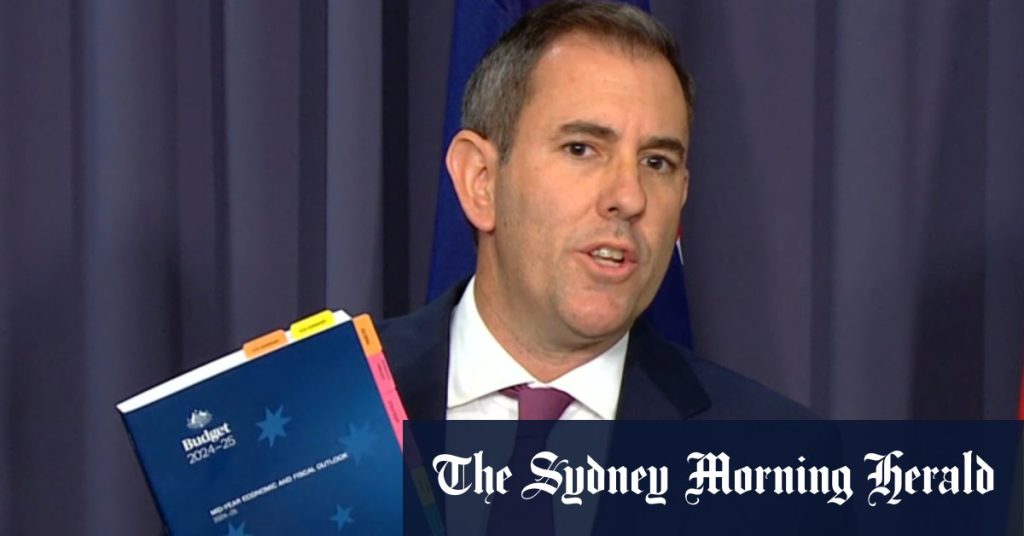Australia’s fiscal outlook has taken a decidedly pessimistic turn, with projections indicating a significant deterioration in the budget deficit over the next four years. The anticipated surge in the deficit stems from a projected mismatch between government revenue and expenditure, with spending expected to significantly outpace incoming funds. This widening gap raises concerns about the nation’s long-term economic stability and the government’s ability to manage its fiscal responsibilities. Several factors contribute to this gloomy forecast, including persistent inflationary pressures, rising interest rates, and a slowdown in global economic growth. These factors impact government revenue streams, increasing the cost of borrowing and potentially dampening economic activity, which in turn reduces tax receipts. Furthermore, increased government spending on essential services, such as healthcare, aged care, and the National Disability Insurance Scheme (NDIS), combined with investments in infrastructure and defense, adds to the upward pressure on expenditures.
The projected increase in the budget deficit presents a significant challenge for policymakers. A larger deficit can lead to increased government debt, requiring higher interest payments, which further strain the budget. It can also potentially erode investor confidence, leading to higher borrowing costs and limiting the government’s ability to fund essential programs. Addressing this widening fiscal gap requires a multi-pronged approach. On the revenue side, options may include broadening the tax base, improving tax compliance, or exploring new revenue streams. On the expenditure side, measures could involve streamlining government operations, prioritizing spending, and finding efficiencies in program delivery. Balancing these measures will be crucial to ensuring fiscal sustainability while maintaining essential services and supporting economic growth. The government must carefully consider the economic and social implications of any policy changes, aiming to minimize the impact on vulnerable populations while addressing the long-term fiscal challenges.
The global economic environment plays a significant role in shaping Australia’s fiscal outlook. A slowdown in global growth can negatively impact demand for Australian exports, affecting the nation’s terms of trade and reducing government revenue. Similarly, rising global interest rates can increase the cost of servicing Australia’s foreign debt, further straining the budget. The interconnected nature of the global economy necessitates a proactive and adaptable approach to fiscal management. The government must closely monitor international developments and adjust its policies as needed to mitigate the impact of external shocks on the domestic economy. Developing strategies to diversify export markets and strengthen trade relationships can help cushion the impact of global economic downturns. Similarly, prudent debt management practices can help mitigate the risks associated with rising global interest rates.
Domestic economic conditions also contribute significantly to the projected budget deficit. Inflationary pressures erode purchasing power, impacting household consumption and business investment, potentially slowing economic growth. Rising interest rates, implemented by the Reserve Bank of Australia to combat inflation, increase the cost of borrowing for businesses and consumers, further dampening economic activity. These factors can lead to reduced tax revenue for the government, exacerbating the budget deficit. To address these challenges, the government may consider implementing policies aimed at stimulating economic growth, such as targeted tax cuts or investments in infrastructure projects. These measures can help boost economic activity, create jobs, and generate additional tax revenue, offsetting some of the pressures on the budget. However, careful consideration must be given to the potential inflationary impact of such policies, ensuring that they do not exacerbate the existing economic challenges.
The projected increase in government spending on essential services, such as healthcare, aged care, and the NDIS, further contributes to the widening budget deficit. These services face increasing demand due to factors such as an aging population and rising healthcare costs. While these services are crucial for the well-being of Australians, their growing cost presents a significant challenge for fiscal sustainability. Finding ways to deliver these services more efficiently and cost-effectively without compromising quality is essential for managing the budget deficit. This may involve exploring innovative service delivery models, leveraging technology, and investing in preventative health measures. Furthermore, addressing the underlying drivers of increasing demand, such as promoting healthy lifestyles and improving access to preventative care, can help contain costs in the long run. The government must carefully balance the need to provide essential services with the imperative to maintain fiscal responsibility, ensuring that these services are sustainable for future generations.
The combination of rising expenditures and potentially slower revenue growth paints a challenging picture for Australia’s fiscal future. Addressing this widening budget deficit requires a comprehensive and long-term approach. The government needs to develop a balanced strategy that addresses both the revenue and expenditure sides of the budget equation. This may involve a combination of measures, including broadening the tax base, improving tax compliance, streamlining government operations, prioritizing spending, finding efficiencies in program delivery, and investing in measures to stimulate economic growth. The government must also carefully consider the economic and social implications of any policy changes, striving to minimize the impact on vulnerable populations while ensuring long-term fiscal sustainability. Regularly reviewing and adapting fiscal policies in response to evolving economic conditions, both domestically and globally, is essential for navigating these challenges and ensuring a healthy fiscal outlook for Australia.

